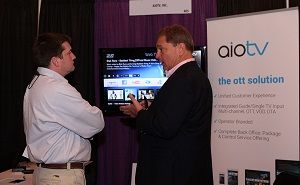NCTC CEO: Programming Issues Top 2014 Priorities

Tampa – NCTC Winter Educational Conference — As they seek ever-expanding distribution rights for TV Everywhere, cloud DVRs and other new types of services and apps, keeping programming costs in check is priority No. 1 for operators, regardless of their size.
Speaking with Multichannel News here at the conference last week, Rich Fickle, president and CEO of the National Cable Television Cooperative (pictured above, photo credit: Krystal Rizzo/Uncharted Video), put programming issues at the top of his agenda for 2014. The NCTC, which negotiates programming and technology deals on behalf of its 900-plus members, also urged this batch of independent operators to make sure their voices are heard.
Historically, the NCTC negotiated the master agreements and members opted in, but Fickle is calling on members to join in and play a “proactive role in our negotiations,” he said.
“We’re finding great benefit in involving the members up front and understanding what their critical issues are and try to work with the program suppliers to customize those deals for smaller markets,” Fickle said, noting that the median size of an NCTC member has 1,500 subscribers. “It’s a different dynamic.”
He said NCTC members must be mindful of how much bandwidth they’re allocating for video services because they need to free up capacity for faster broadband tiers. “That bandwidth tradeoff is pretty acute, much more so than a large market,” Fickle said, noting that the NCTC is also developing plans to help its members deploy and manage Wi-Fi networks.
But to keep video needs in check, the NCTC is trying to hammer out new, more flexible deals that require members to take less than a programmer’s full load, say carrying at least three channels in a package of six. While NCTC has had had tough time convincing many larger programmers to tweak their bundling options for smaller operators, Fickle said “we’ve had some good luck” with others, but wouldn’t name them.
IP Video Options Abound
Multichannel Newsletter
The smarter way to stay on top of the multichannel video marketplace. Sign up below.
Freeing up spectrum for broadband has become critical to the NCTC constituency because most don’t offer their own video-on-demand services and are looking to fill the gap with over-the-top options.
While squeezing services like Vudu or Amazon Instant Video into an IP-capable set-top is among the ideas being explored, Fickle also believes there’s an opportunity for operators to integrate broadband-delivered TV Everywhere streaming apps into the set-top box.
“TV Everywhere apps have much deeper libraries” than traditional VoD, Fickle said. “It’s nice to have that on your iPad, but why don’t we make sure we can do this on the television in some of these markets too?” Fickle said the NCTC is trying to negotiate such rights with programmers.
One MSO that’s already trying out that model is Comcast, which integrated the NBC Sports Live Extra app on the X1 platform during the Sochi games.
Comcast is looking to license the cloud-powered X1 platform, but Fickle believes NCTC members won’t be ready to deploy and support that infrastructure anytime soon. But based on what was on the show floor, NCTC members are not short of options.
Evolution Digital and U.K.-based set-top maker Pace both showed off early iterations of IP-capable Digital Transport Adapters. In addition to providing some future-proofing during an operator’s IP video transition, this new class of device is also capable of pumping over-the-top or perhaps even MSO-managed IP video.

As a successor to the current crop of QAM-only standard – and high-definition DTAs, the hybrid IP versions are capable of supporting an operator’s broadcast QAM video alongside the IP spigot.
Evolution’s demo showed the device running the TiVo user interface and cloud-based recommendation and search capabilities. Even without a CableCARD, the box “offers the full TiVo experience,” including a “universal search” function that’s technically capable of cross-indexing broadband content as well as apps like Netflix, Amazon Instant Video and even the Comcast-owned Streampix service, Brent Smith, Evolution’s president, said.
Smith said Evolution expects its IP-DTA platform, which uses Broadcom chips, to be ready for U.S. trials later this year, noting that any operator that has upgraded systems to support DTA security are in position to support the new hybrid device. Evolution has sold DTAs to more than 50 U.S. cable operators. Some international MSOs have already begun to deploy Evolution's hybrid DTAs, Smith said.
On the topic of U.S. cable distribution, a lingering question is whether hybrid DTAs will require a special waiver from the FCC. The Commission has already granted a blanket waiver that allows MSOs to deploy QAM-only SD and HD DTAs with integrated security.
Smith said Evolution and operator partners are currently seeking clarification from the FCC on whether hybrid DTAs would also be covered by the existing waiver.
Pace didn’t have a live demo, but did show a hybrid DTA hardware that is “in development,” a Pace official said.
Integrated IP is just one of the ways suppliers and operators are looking to add mileage to the DTA platform. Denver-based aioTV also demonstrated (photo at right; credit: Krystal Rizzo/Uncharted Video, courtesy of NCTC) an Android-powered “PassBox” that, when tethered via an HDMI cable, can offer a mix of OTT content alongside the operator’s linear TV feeds.

Adara Technologies, meanwhile, is making progress with a hosted switched IP platform that can live alongside a legacy system that uses headends and set-tops from Motorola/Arris. As an alternative to DTA-driven analog-reclamation strategies, Adara’s approach relies on a video switching fabric, set-tops and gateways, and a customizable user interface from tech partner Cisco Systems.
The system switches rather than broadcasts an MSO’s full live TV lineup. It delivers that video in IP format to the edge QAM, where it is converted into an MPEG transport stream and shuttled along to the customers’ Cisco-made set-tops.
In the case of Cass Cable, an operator with 16,000 subs in central Illinois, it’s using the Adara/Cisco platform to pitch a lineup of about 350 channels, with about 120 in high-definition. The MSO’s legacy Motorola platform offers about 30 channels in HD.
Mark Guerrazzi, a former Cisco exec who is now VP of sales at Adara, said between 75 to 80 operators are at various stages of deployment, and expects that number to reach about 200 by mid-year.
The NCTC said this year’s event drew more than 600 members and exhibitors and 621 attendees, the most since 2008 when operators were gearing up for the broadcast TV digital transition.










